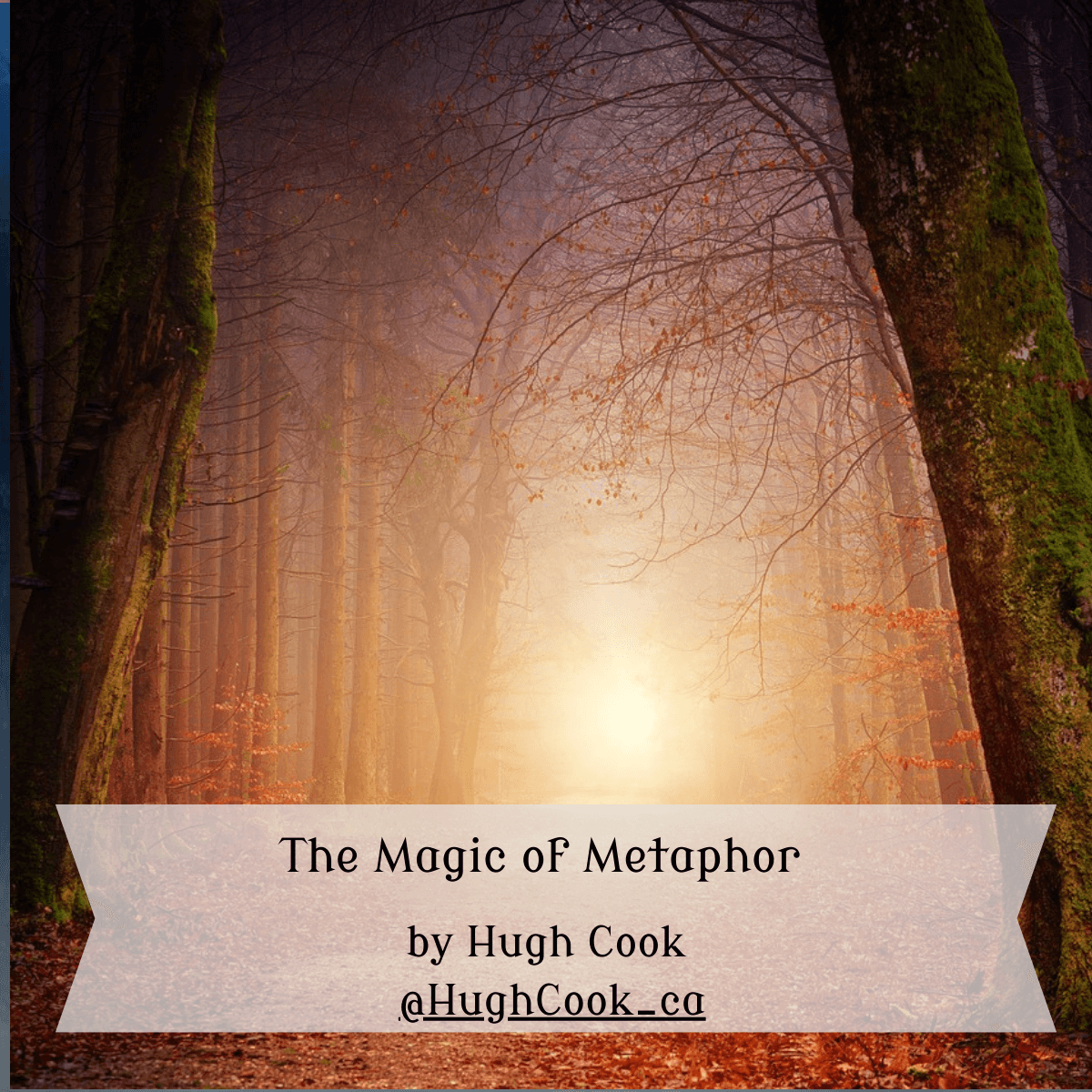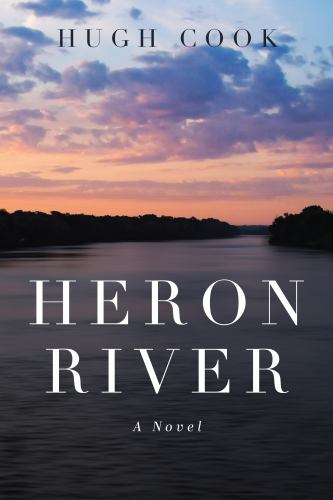by Hugh Cook
A quick look at our everyday language indicates that metaphor is an essential part of our casual conversations. Metaphors roll off our tongues as easily as, well, falling off a log.
Consider the following:
Negotiations between the company and the union are now on thin ice.
That salesman’s promises seem hollow.
After her accident my sister feels a bit fragile.
I haven’t golfed for a while and my game’s really rusty.
Metaphor pervades our everyday speech without our even consciously thinking about it. Think of the many ways we use parts of the human body as metaphors: we speak of the arm of the law; the eye of a storm; the mouth of a river; the foot of the bed; the hands of a clock; the legs of a chair.
Or consider how we describe ideas by using food as a metaphor, so that we say, “What you said in our argument left a bad taste in my mouth,” or “He spoke so fast it was hard to digest it all,” or, “His denial of global warming consists of some pretty half-baked ideas.”
Since we use metaphor frequently in our everyday speech, it’s no surprise that we also use metaphor pervasively in our writing. Metaphor is not just a device to spice up our poetry or prose, or an ornament to make our writing more colorful. Metaphor is a basic tool of comprehension, a strategic instrument of understanding.
We’ve all experienced the feeling that the most effective way to say what we mean is by way of a metaphor; at times the quickest route of comprehension goes through the detour of metaphor. That’s probably what Emily Dickinson meant when she said, “Tell all the truth but tell it slant / Success in circuit lies.”
One of the amazing things about metaphor is that out of the many possible associations a metaphor can evoke, the mind—like a chicken pecking the wheat and leaving the chaff— automatically tends to select the right comparisons and rejects the irrelevant associations. In fact, we’re so used to hearing metaphors that we immediately intuit the figurative, rather than the literal, meaning.
If metaphor is indeed a basic means of comprehension that lies at the heart of the way in which we communicate, how can we use it more effectively in our writing? What, precisely, does metaphor do for our writing? I will mention five advantages of metaphor, which I will illustrate with examples. And I will offer examples from a variety of literary forms—poetry, fiction, drama—to illustrate the variety of literary genres in which metaphor can be used. (As you’ve seen, I include simile under the larger heading of metaphor).
1.Metaphor compresses, compacts, condenses, allowing us to say a great deal in a few words. When Robert Burns says, “O my luve is like a red, red rose,” our minds immediately intuit a number of associations for the poet’s lady: she is beautiful, fresh, fragrant, natural, healthy, passionate—the rose is not “yellow” or “white,” not even just “red,” but “red, red.” Maybe, even, if you think of thorns, she exudes a hint of danger.
2.Metaphor allows us to express intense emotion without resorting to the twin dangers of abstraction or sentimentality. When Macbeth is informed, in Act V of the play, that Lady Macbeth is dead, he states, “She should have died hereafter,” and laments:
Tomorrow, and tomorrow, and tomorrow,
Creeps in this petty pace from day to day
To the last syllable of recorded time,
And all our yesterdays have lighted fools
The way to dusty death. Out, out, brief candle!
Life’s but a walking shadow, a poor player
That struts and frets his hour upon the stage
And then is heard no more.
All the metaphors running through this passage work powerfully to convey to us Macbeth’s emotions regarding the brevity of life and his realization that after his murderous drive for power life is meaningless. Through the metaphors, Shakespeare avoids an abstract polemic on this topic. The passage also illustrates well the writing principle for fiction that if your character’s emotions are extremely strong at a given moment, it is usually best not to describe the emotions directly.
3. Metaphor allows us to describe a character in fiction in a way that allows the writer to obey the mantra “show, don’t tell.” When Flannery O’Connor, in her story “A Good Man Is Hard to Find,” says of the children’s mother that she had “a face as round and innocent as a cabbage,” the metaphor not only describes the character physically, it conveys a distinct attitude towards the mother as well. As Janet Burroway points out in her book Writing Fiction, “a soccer ball is also round and innocent; so is a schoolroom globe; so is a streetlamp. But if the mother’s face had been as round and innocent as any of these things, she would be a different woman altogether.” Now, with the metaphor of a cabbage, O’Connor suggests qualities of a countrywoman, of heaviness, of innocence and perhaps of a lack of intelligence. In other words, a judgment about the character is being conveyed. But the reader draws the judgement, rather than feeling the author is being judgmental or harsh.
Similarly, notice how Washington Irving uses metaphor to describe Ichabod Crane in his classic short story “The Legend of Sleepy Hollow”:
He was tall, but exceedingly lank, with narrow shoulders, long arms and legs, hands that dangled a mile out of his sleeves, feet that might have served for shovels, and his whole frame most loosely hung together. His head was small, and flat at top, with huge ears, large green glassy eyes, and a long snipe nose, so that it looked like a weathercock, perched upon his spindle neck, to tell which way the wind blew.
Clearly, the tone Irving conveys here through metaphor and hyperbole is comic satire.
A similar use of metaphor and hyperbole, although in a much kinder and gentler tone, is Anne Tyler’s memorable characterization of a woman in her novel The Beginner’s Goodbye: “An aging girl, was what she was, and had been from earliest childhood. Her shoes were Mary Janes, as flat as scows in order to minimize her height. Her elbows jutted like coat hangers, and her legs descended as straight as reeds to her Ping-Pong-ball anklebones.”
In short, metaphor is an effective means of both describing a fictional character, and of shaping the reader’s response to that character as well.
4. Metaphor allows us to illustrate or explain a complex thought or an abstract idea. For instance, in order for us to understand the complex phenomenon of a cause creating an effect, which in turn becomes a cause that creates an effect, which again in its turn becomes a cause creating an effect, we use the appropriate metaphor of a “domino effect.” Many complex ideas in the natural sciences are explained by way of metaphor. Eighteenth century science, for example, explained the complex relationship that exists between a Prime Mover, humankind, and the natural world as a “clockwork mechanism.”
5. Metaphor gives us delight, usually because of the element of surprise at the unlikeness, yet the likeness, of the two things being compared. Think again of the delightful metaphors in some of the examples above. The poetry of seventeenth-century poet John Donne is filled with such ingenious comparisons, as in his poem “A Valediction: Forbidding Mourning.”
One of the more delightful poems I’ve received from my creative writing students is the following poem “Catlife.” Read it and you will be delightfully startled by its surprising comparison:
The life I leave when I see you
bides its time with an arched back,
waits with expectant eyes,
broods with a twitching tail.
The life I see when I leave you
lies in a weary gray lump,
limply resists picking up,
and lands feet up when dropped.
In closing, let me suggest a number of writing exercises that use metaphor as an effective means of communicating. (On the internet, look up the poems I mention).
1.Write a poem which is unified through a single extended metaphor, as in Emily Dickinson’s poem “Because I Could Not Stop for Death” or Linda Pastan’s poem “Jump Cabling.”
2. Write a poem which contains a number of metaphors for one thing, as in Mark Irwin’s “Icicles,” or in Sylvia Plath’s “Metaphors”—be forewarned: Plath’s poem is a complex riddle! See if you can solve it. A hint: count the number of lines, and the number of syllables in each line. (Feel free to email me for the answer if you don’t see it and you’re feeling extremely exasperated: hughcook212@gmail.com).
3. In a novel or a short story you’re writing, use original metaphor to describe one of your characters, or to indicate authorial tone towards that character, be that tone critical, satirical, or gentle and kind.
4. Write a poem or a piece of prose that explores the metaphoric possibilities within a color. Write down all the emotional associations that the color evokes. For example, red suggests anger, passion, heat, and so on. Consider, for instance, how Nathanel Hawthorne uses these associations to describe Hester Prynne in his classic novel The Scarlet Letter. The color white suggests purity, emptiness, blankness, and so on. Think of how powerfully Herman Melville discusses associations of the color white in “The Whiteness of the Whale” chapter in his great novel Moby-Dick. Don’t be afraid to include your very personal associations with the color; then write a poem or a piece of prose that incorporates these associations.
5. In the script of a play, have one of the characters express deep feeling, not by naming the feeling, but by using metaphor.
Hugh Cook holds an MFA in fiction writing from the Writers’ Workshop at the University of Iowa. He has published two books of short stories and two novels. Readers can obtain his recent novel Heron River at
Amazon and at Barnes and Noble . Send him a query at hughcook212@gmail.com.
The Magic of Metaphor and How to Use it by @HughCook_ca Share on X



Thanks for the post, Hugh. You're absolutely right; a good metaphor is a delight to read. I always smile at the clever ones.
Thanks for posting, Elizabeth.
Details like metaphors can really make the language of a story come alive, if I can put it that way. And, for readers who are visual thinkers, they can be really helpful in drawing the reader into the story. Thanks for this!
Very true, Margot.
I never thought about how we use metaphors when we talk, but you're right. Thanks for the great post.
Thanks, Natalie. Metaphors often come to us without our thinking about it, right? They're an essential part of our speech.
I like the idea of writing down all the things a color invokes. I probably don't use metaphors as often as I should in writing.
Thanks, Alex. Yes, just let your imagination go, playing with the connotations of a color.
Metaphors are a great way of adding color without making prose too flowery.
Right! And metaphors not only add color, they also convey deep meaning.
Metaphors are wonderful, for sure!
So true!
Metaphors are fun!
I'm a pretty spare writer, but whenever I find myself writing a cliche, I aim for a new metaphor with the same meaning.
Great tips!
Thanks, Jemi. I hope you find them useful.